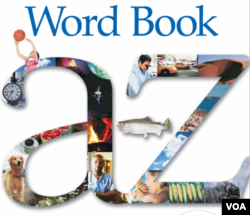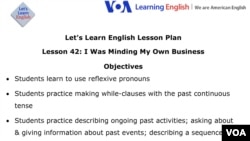Summary
Anna sees a crime and tries to help find the robbers. She hurts her arm. The news reporter wants to know, "How did she hurt herself?"
Anna menyaksikan tindak kejahatan dan mencoba menemukan perampoknya. Tangannya terluka. Reporter ingin mengetahui, "Kenapa tangannya bisa terluka?"
Speaking
In this video, learn how to say the new words. Then learn how to use reflexive pronouns like herself, ourselves, and yourself.
Dalam video ini, belajar mengatakan kata-kata baru. Selain itu belajar menggunakan pronouns refleksif seperti herself, ourselves, dan yourself.
Pronunciation
Use this video to understand how English speakers pronounce the words "did you" quickly and learn to say them as /didjə/.
Gunakan video ini untuk mengerti bagaimana mengucapkan "did you" dengan cepat dan belajar mengucapkan kata tersebut dengan /didjə/.
Conversation
Guy: Hello. I'm Guy Newsman with News Channel XYZ. I’m here in Washington, D.C. at the scene of a crime.
Writing
In this lesson, Anna hurt herself in the vending machine. Did you ever hurt yourself by accident? What were you doing when you hurt yourself? Write to us by email or in the Comments section.
Click on the image below to download the Activity Sheet and practice writing and using the past continuous tense and reflexive pronouns.
Learning Strategy
Learning Strategies are the thoughts and actions that help make learning easier or more effective.
The learning strategy for this lesson is Read Between the Lines. This expression means to find a hidden meaning in something said or written.
In this lesson, Guy Newsman asks Anna many questions. Anna tells him a long story about the crime. But she doesn't explain how she hurt her arm until the end. Guy reads between the lines each time he guesses about how she hurt her arm.
Do you ever read between the lines to understand what you hear or read in English? Write to us about it in the Comments section or send us an email. Teachers, see the Lesson Plan for more details on teaching this strategy.
Quiz
Listen to short videos and test your listening skills with this quiz.
______________________________________________________________
New Words
|
Subject Pronouns (Lesson 2) |
Object Pronouns (Lesson 18) |
Possessive Adjectives (Lesson 15) |
Possessive Pronouns (Lesson 37) |
Reflexive Pronouns (Lesson 42) | |
|
1st person |
I |
me |
my |
mine |
myself |
|
2nd person |
you |
you |
your |
yours |
yourself |
|
3rd person (female) |
she |
her |
her |
hers |
herself |
|
3rd person (male) |
he |
him |
his |
his |
himself |
|
3rd person (neutral) |
it |
it |
its |
(not used) |
itself |
|
1st person (plural) |
we |
us |
our |
ours |
ourselves |
|
2nd person (plural) |
you |
you |
your |
yours |
yourselves |
|
3rd person (plural) |
they |
them |
their |
theirs |
themselves |
______________________________________________________________
Free Materials
Download the VOA Learning English Word Book for a dictionary of the words we use on this website.
Each Let's Learn English lesson has an Activity Sheet for extra practice on your own or in the classroom. In this lesson, you can use it to practice using the past continuous tense and reflexive pronouns.
Untuk the VOA Learning English Word Book sebagai kamus kata-kata yang digunakan di situs ini.
Masing-masing pelajaran dalam Let's Learn English, ada Activity Sheet agar Anda bisa belajar sendiri atau di kelas. Di pelajaran kali ini, Anda bisa menggunakannya untuk berlatih menggunakan past continuous tense dan reflexive pronouns.
For Teachers
See the Lesson Plan for this lesson for ideas and more teaching resources. Send us an email if you have comments on this course or questions.
Grammar: Reflexive pronouns; While-clauses; Past Continuous Tense,
Topics: Describing ongoing past activities; Asking about & giving information about past events; Describing a sequence of events; Expressing concern about someone; Reacting to bad news; Expressing sympathy
Learning Strategy: Read Between the Lines
Speaking & Pronunciation: Reflexive pronouns; Pronouncing /didjə/
____________________________________________________________
Now it's your turn. Send us an email or write to us in the Comments section below or on our Facebook page to let us know what you think of this lesson.




















